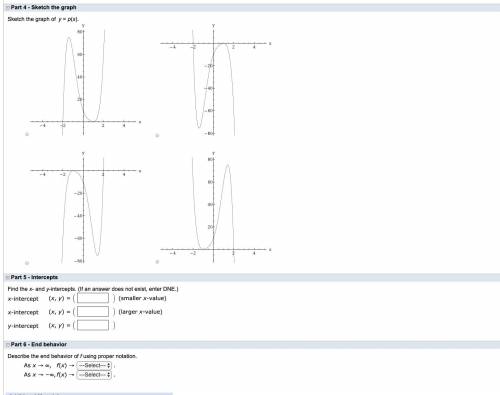khohenfeld0
27.06.2020 •
Mathematics
Please help! Let p(x) = 5x^5 + 5x^4 − 10x^3 − 25x^2 − 25x − 10. 1. Use the Rational Zeros Theorem to generate a list of potential rational zeros. (Enter your answers as a comma-separated list.) 2. Use Descartes' Rule of Signs to find the possible number of positive and negative real zeros. (Enter your answers as a comma-separated list.) 3. Find all real zeros of p and state their multiplicities. 4. Sketch the graph 5. Find the x- and y-intercepts. (If an answer does not exist, enter DNE.) 6. Describe the end behavior of f using proper notation.


Solved
Show answers
More tips
- C Computers and Internet How to Get Rid of 3pic Infector: Everything You Need to Know...
- A Auto and Moto Experience the World of the Most Expensive Cars on the Planet...
- S Style and Beauty How to Get Rid of a Double Chin?...
- F Food and Cooking How to Cook Julienne? Recipes and Tips...
- D Dating, Love, Relationships 10 Useful Tips on How to Survive a Breakup?...
- F Food and Cooking Apple Cider Vinegar: The Ultimate Health and Beauty Solution...
- C Computers and Internet Е-head: How it Simplifies Life for Users?...
- F Family and Home How to Choose the Best Diapers for Your Baby?...
- F Family and Home Parquet or laminate, which is better?...
- L Leisure and Entertainment How to Properly Wind Fishing Line onto a Reel?...
Answers on questions: Mathematics
- M Mathematics Steven is comparing One-fourth and Four-fifths using benchmarks 0 and 1. Which statement is true? One-fourth is closer to 1 than to 0. Four-fifths is closer to 0 than to 1. One-fourth...
- M Mathematics Let X be a random variable with probability mass function P(X = 1) = 1 2 , P(X = 2) = 1 3 , P(X = 5) = 1 6 (a) Find a function g such that E[g(X)] = 1 3 ln(2) + 1 6 ln(5). Your...
- M Mathematics Connor and maria are doing yard work for a neighbor. they make a total of $503.56 . since maria works fewer hours than connor , maria gets 31 % of the money. about how much (in...
- W World Languages Copyright Pearson, Inc. El verbo correcto A. Fill in the blanks below with all the forms of the verbs given. 1) comer yo: tú: él/ella/Ud.: come nosotros/nosotras: vosotros/vosotras:...
- G Geography What two physical features shape farming and trade in central asia and caucasus region...
- C Chemistry Auniform clear liquid that when evaporated produces a transparent gas and a white solid...
- M Mathematics What is the modulus of z? 2 2StartRoot 2 EndRoot 3 StartRoot 10 EndRoot...

Ответ:
step1: x*5=45*7
step2: x=315/5
step3: x=63